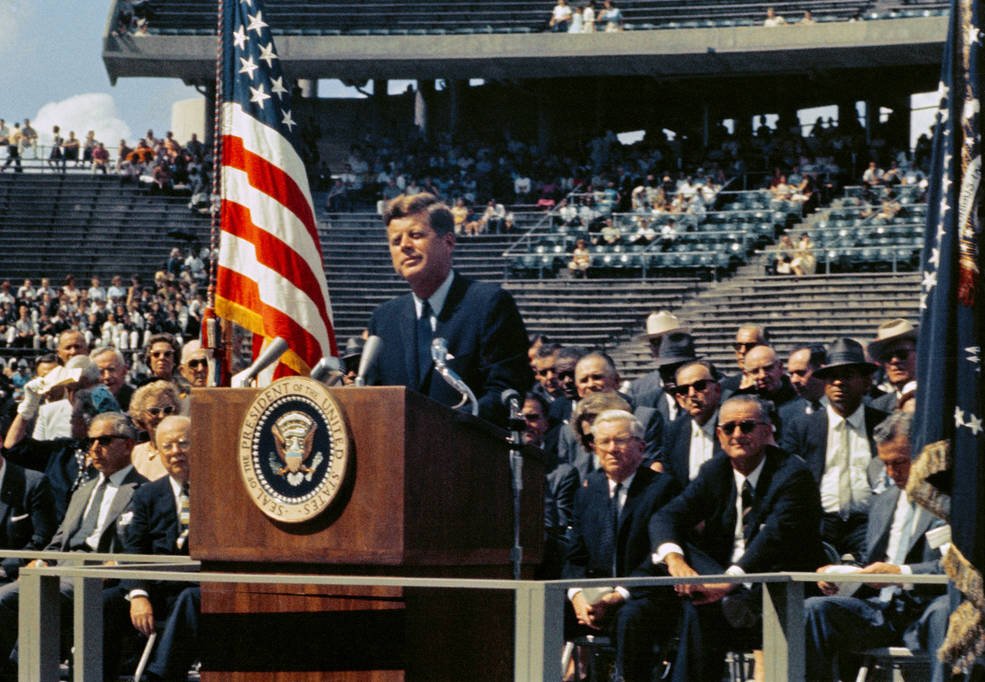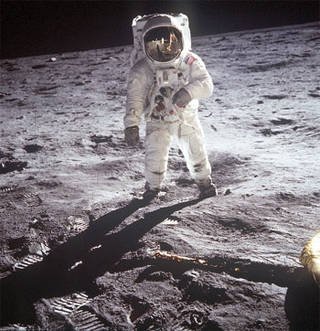One Giant Leap for Mankind: Humanity Steps into Cosmos
Human space travel stands as a testament to our innate curiosity and relentless pursuit of exploration. From Yuri Gagarin's orbit around the Earth in 1961 to the ongoing achievements of the International Space Station, each milestone has shaped our understanding of the universe and advanced human capabilities. As we examine human space travel's history and current state, it is important to anticipate the future. Space exploration is poised for remarkable breakthroughs with plans to return to the Moon and establish a sustainable presence, and the potential for manned missions to Mars.
Wernher Von Braun and V-2 missile. Image credit: © BBC News. All rights reserved.
The ancestor of today’s modern rocketry is the V-2 missile. The “V” in V-2 stood for Vergeltungswaffe [vengeance weapon] (Magazine & Edwards, n.d.). It was manufactured in Germany during World War II under the supervision of a German rocket scientist, Wernher von Braun, who later joined NASA and led the making of Saturn-V rockets that took the astronauts to the moon for the first time in history. Von Braun made a missile that was used by Germany to attack its enemies during World War II (Magazine & Edwards, n.d.). The knowledge and expertise gained from the V-2 program fueled a race to conquer the cosmos, resulting in significant advancements in space technology and exploration in the decades that followed (Space Exploration - History, Technology, Benefits | Britannica, n.d.).
During the 20th century, before the V-2 program was even a dream, Dr. Robert Hutchings Goddard emerged as one of the ancestors of spaceflight. Since his youth, he was convinced of the possibility of space exploration and humanity's ability to travel beyond Earth using rockets (Garner, 2015). In 1901, he authored "The Navigation of Space," proposing propulsion through firing cannons arranged like a "nest" of beakers. During his 1904 high school oration, he expressed his life's perspective: "It is difficult to say what is impossible, for the dream of yesterday is the hope of today and the reality of tomorrow." In 1907, another paper he wrote exploring the use of radioactive materials for interplanetary propulsion faced rejection from multiple magazines (Spaceflight: Robert H. Goddard, n.d.).
Robert H. Goddard and his first liquid-fueled rocket, March 16, 1926. © NASA. All rights reserved
His most significant breakthrough came in 1926 when he successfully tested the first rocket using liquid fuel. Goddard's contributions to rocketry and spaceflight were foundational. He established the concept of escape velocity [the minimum velocity to escape the gravitational pull of a planet or any other object] and proved rockets' ability to work in a vacuum. He pioneered scientific instruments on rockets, gyroscopic stabilization, exhaust gas deflection for steering, and film cooling to prevent engine melting—a feature seen in modern rocket engines, including the German V-2 and post-WWII developments influenced by Goddard's pre-war work.
Despite all these efforts, he made a lesser impression, and his worth was realized when the USSR launched humanity’s first-ever satellite into Earth's orbit in 1958—an achievement that posed a potential threat to the United States if the USSR succeeded in the space race. In 1959, Congress acknowledged Goddard's contributions by awarding him a gold medal and recognizing him as the "father of space flight." NASA named the Goddard Space Flight Center in Maryland in his honor that same year (Dr. Robert H. Goddard, n.d.).
Following the research and developments of the V-2 missile. Along with German prisoners, Russian rocket scientist Sergey Korolev led the Russian Space Program and put the first man-made object in earth orbit, the Sputnik Satellite in 1957. Later, during 1960-1963, planning for manned missions began which aimed at sending the first cosmonaut into lower earth orbit. This proved to be a great success for the USSR in the space race when Yuri Gagarin completed his mission in 1961 aboard Vostok 1 (Soviet Space Program | National Cold War Exhibition, n.d.).
Cosmonaut Yuri Gagarin. Image source: The Guardian
The program achieved several milestones, including the first woman in space, Valentina Tereshkova. However, Korolev passed away in 1966, and responsibility for the program fell to Vasily Mishin. Despite setbacks and the United States' successful moon landing in 1969, the Soviet program continued until it was eventually canceled in 1974 (Soviet Space Program | National Cold War Exhibition, n.d.).
Image Credit: NASA
“We choose to go to the Moon in this decade and do the other things, not because they are easy, but because they are hard”
-President John Kennedy
In response to the USSR's advancing progress in the space race, President John F. Kennedy delivered a significant address to a Joint Session of Congress in 1961. In this speech, he declared the United States' ambitious goal of landing humans on the moon by the decade's end (The Decision to Go to the Moon, n.d.). The National Space and Aeronautics Agency initiated the Apollo Program, the pinnacle of this journey was reached when Neil Armstrong and Buzz Aldrin became the first humans to step on the moon in July 1969, marking a monumental achievement for the United States (Apollo | History, Missions, Significance, & Facts | Britannica, 2023). However, It is worth noting that only 12 of the 24 astronauts sent to the moon walked on its surface (Apollo | Britannica, 2023).
Credits: NASA
After the termination of the Apollo Program in 1971, there have been no human landings on the Moon. Currently, NASA is actively considering the revival of lunar landings through the Artemis Program. The Artemis II crew was announced in April 2023, and it includes NASA astronauts Reid Wiseman, Victor Glover, and Christina Hammock Koch, along with CSA astronaut Jeremy Hansen (O’Shea, 2023).
The crew of NASA’s Artemis II mission (left to right): NASA astronauts Christina Hammock Koch, Reid Wiseman (seated), Victor Glover, and Canadian Space Agency astronaut Jeremy Hansen.
Credits: NASA
At the forefront of this transformative era stands Elon Musk and his brainchild, SpaceX, akin to the visionary path blazed by Wernher von Braun and the Apollo program. Musk's unwavering commitment to pushing the boundaries of space travel has spearheaded a paradigm shift, redefining the landscape of private space agencies. Embracing an ideology rooted in the relentless pursuit of efficiency and sustainability, SpaceX introduced the concept of reusable rockets – a modern-day echo of the innovative strides made during the Apollo program. By achieving successful landings and subsequent relaunches of rocket stages, Musk's SpaceX has not only shattered cost barriers but has also illuminated an alluring path for other private ventures like Blue Origin and Virgin Galactic. This audacious stride towards reusability has, in turn, ignited a new era of competition and collaboration, propelling the collective dream of widespread space exploration and accessibility to new horizons (Shammas & Holen, 2019).
Successful Launch of Space-X's Falcon 9 rocket. All rights reserved Daily Mail
As we reflect on these milestones, we find ourselves at a juncture where the legacy of exploration continues through initiatives like the Artemis Program, poised to rekindle human presence on the Moon and beyond. This new era of collaboration and competition not only promises to push the boundaries of possibility but also heralds a future where the cosmos beckons us to explore, inspire, and unite. As we marvel at the journey thus far, we stand on the cusp of a new chapter, one that holds the promise of boundless discovery and the enduring pursuit of the stars.
Works Cited
Apollo | History, Missions, Significance, & Facts | Britannica. (2023, June 30). https://www.britannica.com/science/Apollo-space-program
Garner, R. (2015, February 11). Dr. Robert H. Goddard, American Rocketry Pioneer [Text]. NASA. http://www.nasa.gov/centers/goddard/about/history/dr_goddard.html
Dr. Robert H. Goddard. (n.d.). National Museum of the United States Air ForceTM. Retrieved July 16, 2023
Shammas, V. L., & Holen, T. B. (2019). One giant leap for capitalistkind: Private enterprise in outer space. Palgrave Communications, 5(1), Article 1. https://doi.org/10.1057/s41599-019-0218-9
O’Shea, C. (2023, April 3). NASA Names Astronauts to Next Moon Mission, First Crew Under Artemis [Text]. NASA. http://www.nasa.gov/press-release/nasa-names-astronauts-to-next-moon-mission-first-crew-under-artemis
Soviet Space Program | Space Race | National Curriculum | Schools & Colleges | National Cold War Exhibition. (n.d.). Retrieved July 18, 2023, from https://www.nationalcoldwarexhibition.org/schools-colleges/national-curriculum/space-race/soviet-space-program.aspx
Space exploration—History, Technology, Benefits | Britannica. (n.d.). Retrieved July 14, 2023, from https://www.britannica.com/science/space-exploration/History-of-space-exploration
The Decision to Go to the Moon: President John F. Kennedy’s May 25, 1961 Speech before Congress. (n.d.). Retrieved August 7, 2023, from https://history.nasa.gov/moondec.html
Magazine, S., & Edwards, O. (n.d.). Wernher von Braun’s V-2 Rocket. Smithsonian Magazine. Retrieved July 14, 2023, from https://www.smithsonianmag.com/arts-culture/wernher-von-brauns-v-2-rocket-12609128/













